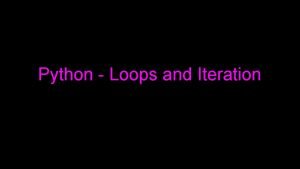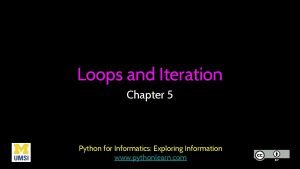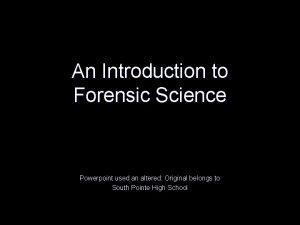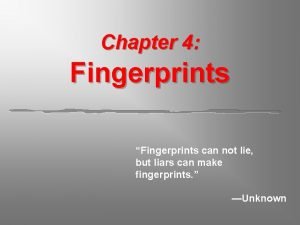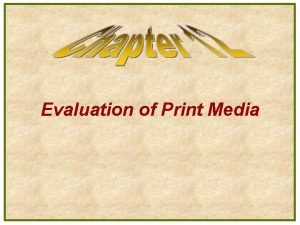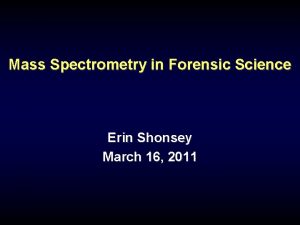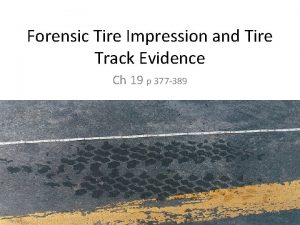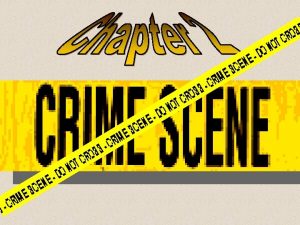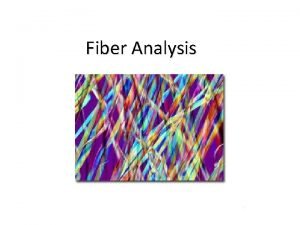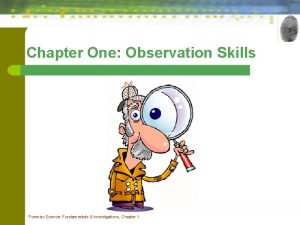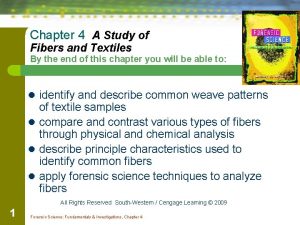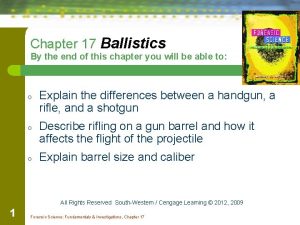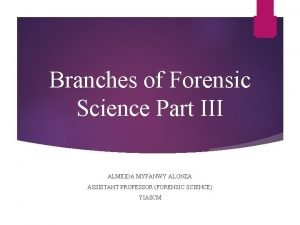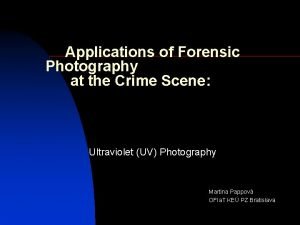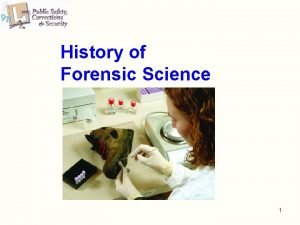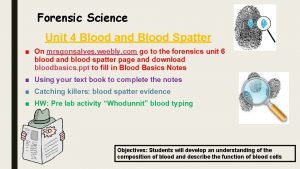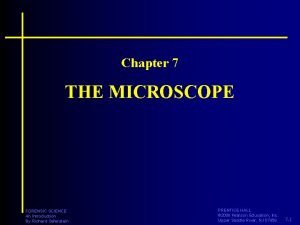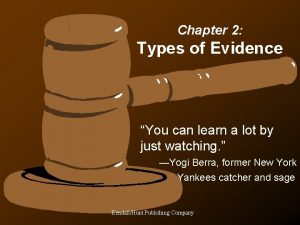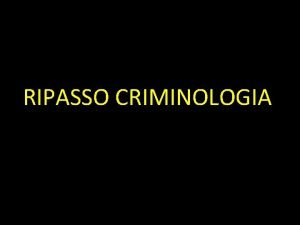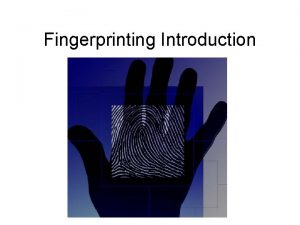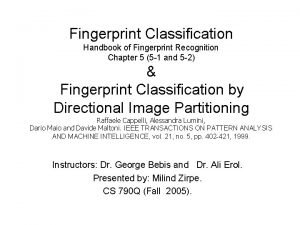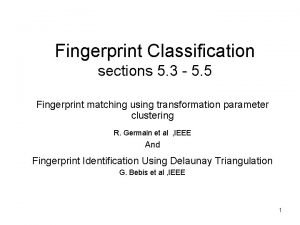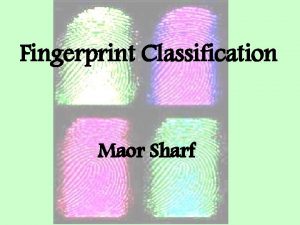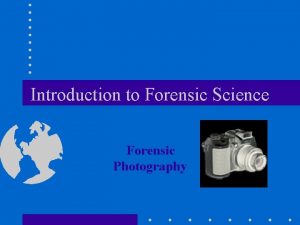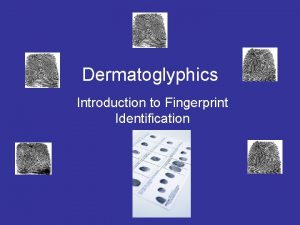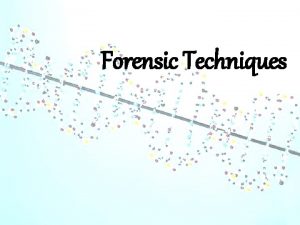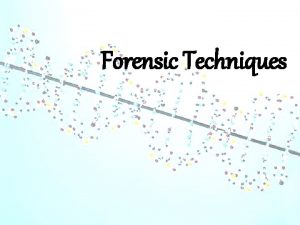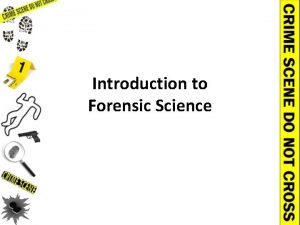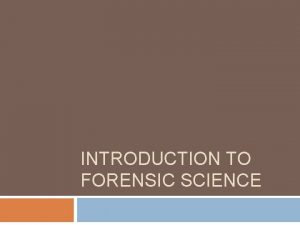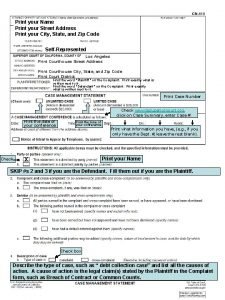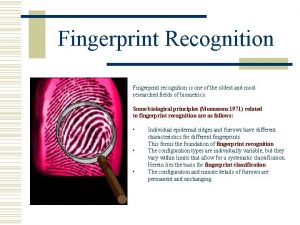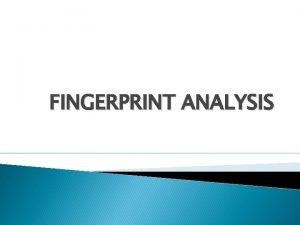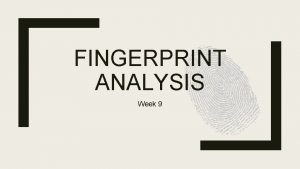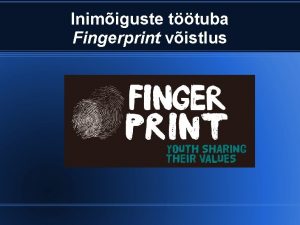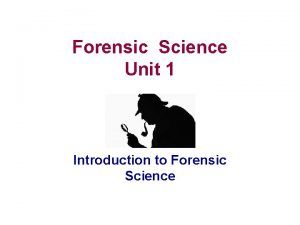Introduction to Forensic Science Latent Print Fingerprint Classification















































- Slides: 47

Introduction to Forensic Science Latent Print Fingerprint Classification

Why Use Fingerprints for Identification They are permanent They are unique

Latent Impressions • Latent - The skin has deposits of oil and perspiration that normally coat its surface. • When the hand touches the surface, some of the moisture is transferred from the hand to the object, leaving an impression of the friction ridge detail. • These are referred to as latent impressions.

Latent Impressions • On most surfaces, latent impressions the impression will are not readily be revealed through visible. the use of available or oblique lighting. • The word latent is defined as not • The impression must visible to the naked be enhanced or eye. developed to be collected and seen • That does not mean completely. that the latent print is actually invisible.

Patent Impressions • Patent – A patent impression occurs as the result of transferring a foreign material coating to the skin of the fingers. • Examples of the foreign material would be substances like paint, tar, grease, blood, or ink.

Patent Impressions • The best example of a patent impression would be the ink standards or eliminations that we, as investigators collect from individuals. – After the ink is applied, it becomes foreign material coating the hands of the individual. – A card is used as a transfer medium, thus becoming the object touched and the transference of the patent impression takes place.

Patent Impressions • The word patent means obvious or evident. • Patent impressions are visible and usually need no enhancement. • They are simply photographed and the item that they are deposited on is collected if necessary. • The photograph or object actually becomes the investigator’s lift.

Plastic or Molded Impressions • A plastic or molded impression is deposited when the hands, fingers, or feet are pressed into a soft, rubbery type material that will retain the impression of the ridge detail.

Plastic or Molded Impressions • The difference between a latent and a plastic or molded print - Where a latent impression is deposited on the surface, a plastic or molded impression would be deposited into the surface. – Examples of the materials where a plastic or molded impression would be deposited are clay, wet paint, blood, or tar.

Plastic or Molded Impressions • Plastic or molded impressions are visible and usually need no enhancement. • They are simply photographed and if necessary, the item is collected and may have the ability to be casted.

How Latent Prints Are Discovered • Alternative Light Source • Chemicals • Powders

Alternative Light Source (Non-laser Light Sources) • Perspiration contains elements that fluoresce when illuminated by laser light. – Fluorescence – luminescence that is caused by the absorption of radiation at one wavelength followed by nearly immediate radiation usually at a different wavelength that ceases almost at once when the incident radiation stops

Alternative Light Sources • Relatively inexpensive and versatile • Comparable results can be attained by modified and filtered xenon arc lamp to those of laser light sources

Chemicals • Iodine Fuming – this is the oldest method for visualizing latent prints – Iodine, a solid crystal, is heated and transformed into a vapor. This is known as sublimination. – The suspect material is put into an enclosed cabinet known as a fuming cabinet.

Iodine Fuming • The iodine crystals are heated and the vapors fill the chamber and combine with the latent print to make it visible. • In order to have a permanent record of the latent prints, the prints must then be photographed immediately or fixed with a 1% solution of starch and water that is sprayed on; for they will fade once the fuming process is stopped.

Ninhydrin • The amino acids present in perspiration chemically react to ninhydrin forming a purpleblue color. – Ninhydrin is sprayed onto the porous surface containing the latent prints. – Within an hour or two the prints begin to appear. – This method has been used on paper up to fifteen years old. – Ninhydrin is often the preferred method because of it is extremely sensitive and easy to apply.

Super Glue Fuming a. k. a. Cyanoacrylate Fuming • This method of visualizing latent prints is used on nonporous surfaces such as metals, electrical tape, leather, and plastic bags. • Cyanoacrylate ester interacts with and visualizes a latent fingerprint. • Super Glue is placed on an absorbent cotton treated with sodium hydroxide. (The glue may also be heated to create fumes. )

Super Glue Fuming • The object and the super glue are both enclosed in the fuming tank for thirty minutes to an hour. Sometimes a latent print can be placed on a black card. • This is placed in the tank for development of the print. This can be used as an indicator for other items in the fuming cabinet.

Super Glue Fuming Tank

Super Glue Fuming • When the fumes from the glue adhere to the latent print, the print often appears white. • Super Glue fuming may now be done using a small portable unit consisting of a handheld wand. This wand is used to hold a small cartridge of Cyanoacrylate and dye mix, which is applied to any areas where latent prints are assumed to be present.

Powders • Latents can be dusted with various colored powders to increase their visibility. – Gray and black powders are sufficient for most latent print work. – The examiner will use the powder that will result in the most contrast. – These powders are applied via camel’s hair or fiberglass brushes.

Powders • Magnetic-sensitive powders may also be used. – A magnetic brush is used to spread the powder over the surface. – The magnetic-sensitive powder is especially useful on plastics and leather. – Fluorescent powders are sometimes used. The print becomes visible under ultraviolet light.

Using More Than One Method On a Latent Print • These methods must be done in a specific order if you wish to use multiple methods on one surface. – First fume with iodine. – Then use ninhydrin.

General Pattern Interpretation • Fingerprints may be placed into three general groups of patterns, each group bearing the same general characteristics or family resemblance. • Loops – 65% of all fingerprints • Arches – 5% of all fingerprints • Whorls – 30% of all fingerprints

Loops, Arches, & Whorls

Pattern Area • Pattern Area – is that part of a loop or whorl in which appear the cores, deltas, and ridges with which we are concerned in classifying. – The pattern areas of loops and whorls are enclosed by type lines.

Core of a Fingerprint • A fingerprint core is an area located within the inner most recurving ridge.

Delta • A delta is that point on a ridge at or nearest to the point of divergence of two type lines, and located at or directly in front of the point of divergence.

Type Lines • Type Lines – may be defined as the two innermost ridges, which start parallel, diverge, and surround or tend to surround the pattern area. • Type lines are not always two continuous ridges. They most often are found to be broken, and sometimes they may be very short. Care must be exercised in their location.

Loops • A loop is that type of fingerprint pattern in which one or more of the ridges enter on either side of the impression, recurve, touch or pass an imaginary line drawn from the delta to the core, and terminate or tend to terminate on or toward the same side of the impression from whence such ridge or ridges entered.

Essentials of a Loop • A sufficient recurve may be defined as that part of a recurving ridge between the shoulders of a loop. • It must be free of any appendages abutting upon the outside of the recurve at a right angle. • Appendage defined - a ridge abutting an otherwise smoothly recurving ridge – A delta – A ridge count across a looping ridge

The Plain Arch • In plain arches, the ridges enter on one side of the impression and flow or tend to flow out the other with a rise or wave in the center. • This is considered the most simple of all fingerprint patterns to recognize.

The Tented Arch

Tented Arch • A tented arch may resemble a loop, but lacks one of the characteristics of a loop • A tented arch possesses either an angle, an up thrust, or two of the three basic characteristics of the loop

Types of Whorls • • The Plain Whorl The Central Pocket Loop Whorl The Double Loop Whorl The Accidental Whorl

Plain Whorl Central Pocket Loop Whorl Double Loop Whorl Accidental Whorl

Plain Whorl DELTA

The Plain Whorl • The plain whorl has two deltas and at least one ridge making a complete circuit. • An imaginary line drawn between the two deltas must touch or cross at least on of the recurving ridges within the inner pattern area. • A recurving ridge, however, which has an appendage connected with it in the line of flow cannot be construed as a circuit. An appendage connected at that point is considered to spoil the recurve on that side.

The Central Pocket Loop Whorl • The central pocket loop whorl has two deltas and at least one ridge, which makes (or tends to make) a complete circuit. • An imaginary line drawn between the two deltas must not touch or cross any of the recurving ridges within the pattern area.

Central Pocket Loop Whorl

The Double Loop Whorl • The double loop whorl consists of – Two separate and distinct loop formations – Two separate and distinct sets of shoulders – Two deltas

Double Loop Whorl

The Accidental Whorl • A fingerprint pattern consisting of two different types of patterns, with the exception of the plain arch, with two or more deltas • Or a pattern which possesses some of the requirements for two or more different types • Or a pattern which conforms to none of the definitions

Accidental Whorl

Galton Details • Galton identified the characteristics by which fingerprints can be identified. • These same characteristics (minutia) are basically still in use today, and are often referred to as Galton's Details.

Galton’s Details • Short ridge - a single friction ridge beginning, traveling a short distance, and ending • Bifurcation – the forking or dividing of one line into two • Ridge ending – a ridge that ends abruptly

Galton’s Details • Island – a single ridge that bifurcates and then runs parallel, and then rejoins as a single ridge • Dot – an isolated ridge unit whose length approximates its width in size.
 Specific latent heat definition
Specific latent heat definition Iteratio.n5 - how many panels?
Iteratio.n5 - how many panels? Iteratio.n5
Iteratio.n5 Introduction to forensic science ppt
Introduction to forensic science ppt Forensic science unit
Forensic science unit Forensic science an introduction
Forensic science an introduction Chapter 1 introduction to forensic science and the law
Chapter 1 introduction to forensic science and the law Forensic pathologist vs forensic anthropologist
Forensic pathologist vs forensic anthropologist Forensic psychiatry vs forensic psychology
Forensic psychiatry vs forensic psychology My favourite subject is c
My favourite subject is c Think central science fusion
Think central science fusion Cyanoacrylate fuming fingerprints
Cyanoacrylate fuming fingerprints Classification of print media
Classification of print media Solapith hymen
Solapith hymen Forensic analysis of hair
Forensic analysis of hair Mass spectrometry in forensic science
Mass spectrometry in forensic science Forensic science branches
Forensic science branches How many men did aileen wuornos kill
How many men did aileen wuornos kill Father of forensic serology
Father of forensic serology Wheelbase definition forensics
Wheelbase definition forensics Serology forensic science
Serology forensic science Forensic science foodborne outbreak investigation answers
Forensic science foodborne outbreak investigation answers What is forensic science definition
What is forensic science definition Forensic science begins
Forensic science begins Forensic science arson activity
Forensic science arson activity The golden book of camping
The golden book of camping Fibers from animals
Fibers from animals How can we as forensic scientists become better observers
How can we as forensic scientists become better observers Weave patterns forensics
Weave patterns forensics Nibis ballistics definition
Nibis ballistics definition Chapter 14 forensic anthropology
Chapter 14 forensic anthropology Forensic science branches
Forensic science branches Forensic photography management
Forensic photography management Rough sketch and final sketch
Rough sketch and final sketch Department of forensic science dc
Department of forensic science dc Hans gross forensic science
Hans gross forensic science Valentin ross forensics
Valentin ross forensics Ballistics and spatter lab
Ballistics and spatter lab Forensic science jobs
Forensic science jobs Forensic entomology worksheet science spot
Forensic entomology worksheet science spot Example of deductive reasoning
Example of deductive reasoning Forensic science microscopes
Forensic science microscopes Example of conditional evidence
Example of conditional evidence Father of bloodstain identification
Father of bloodstain identification Edmond locard forensic science
Edmond locard forensic science Bertillonage
Bertillonage Glass composition analysis
Glass composition analysis Fundamental principles of fingerprints forensic science
Fundamental principles of fingerprints forensic science

